Analysis of Toyota's Management and Operational Strategies
VerifiedAdded on 2020/12/09
|17
|4499
|325
Report
AI Summary
This report provides an in-depth analysis of Toyota's management and operations. It begins with an introduction to the company, its management structure, and the roles of leaders and managers. The report then delves into a comparison of management and leadership, exploring their characteristics and functions. It analyzes various management and leadership theories, including system theory, situational theory, and contingency theory, and assesses their application within Toyota's organizational context. The strengths and weaknesses of these leadership approaches are evaluated. Furthermore, the report examines key operational functions, approaches to operations management, and the impact of external business environment factors on decision-making. It also explores how operational efficiencies can be improved, culminating in conclusions and recommendations for future improvement within Toyota. The report emphasizes the importance of leadership and management in driving Toyota's success and provides insights into how the company can further enhance its operational performance.
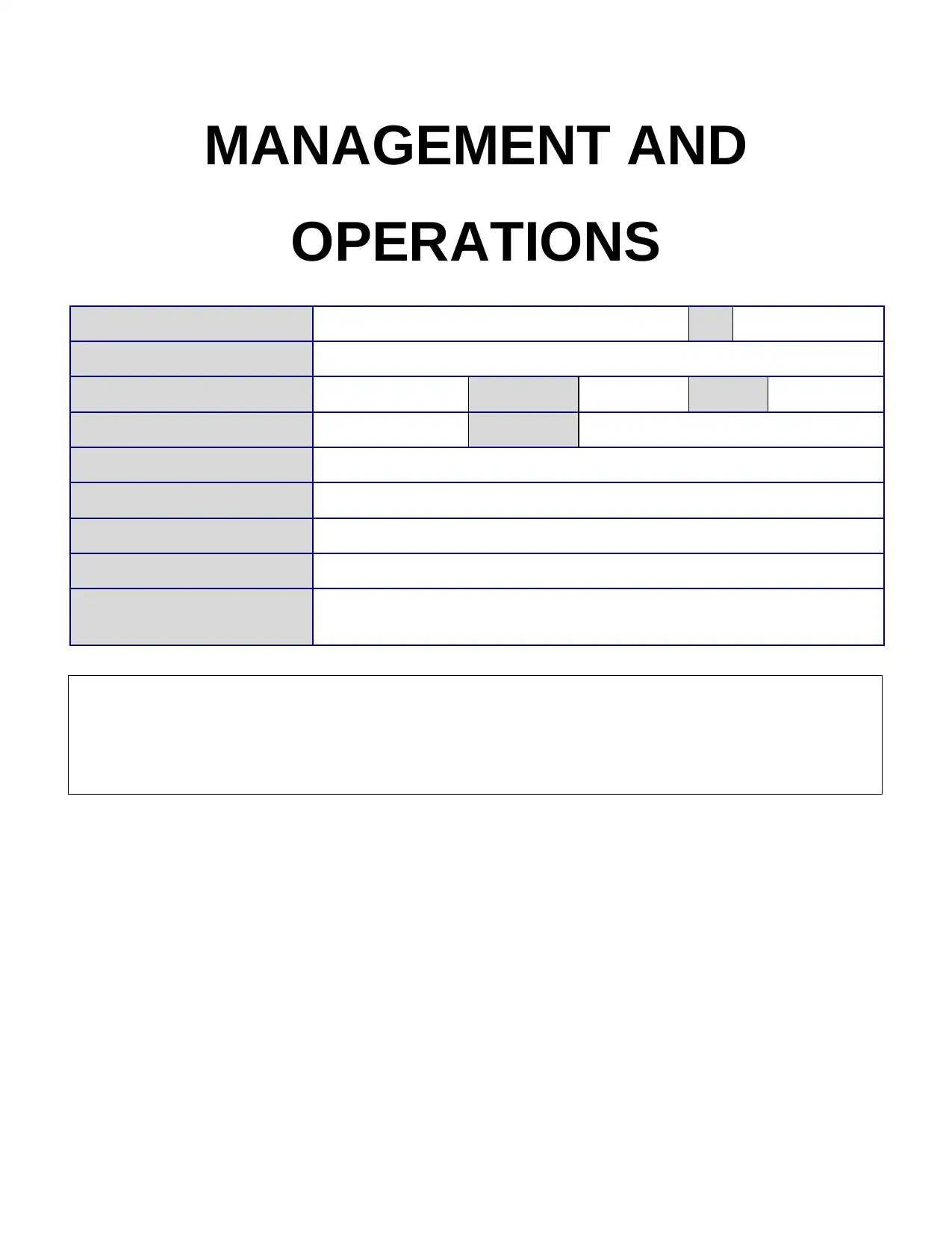
MANAGEMENT AND
OPERATIONS
OPERATIONS
Paraphrase This Document
Need a fresh take? Get an instant paraphrase of this document with our AI Paraphraser
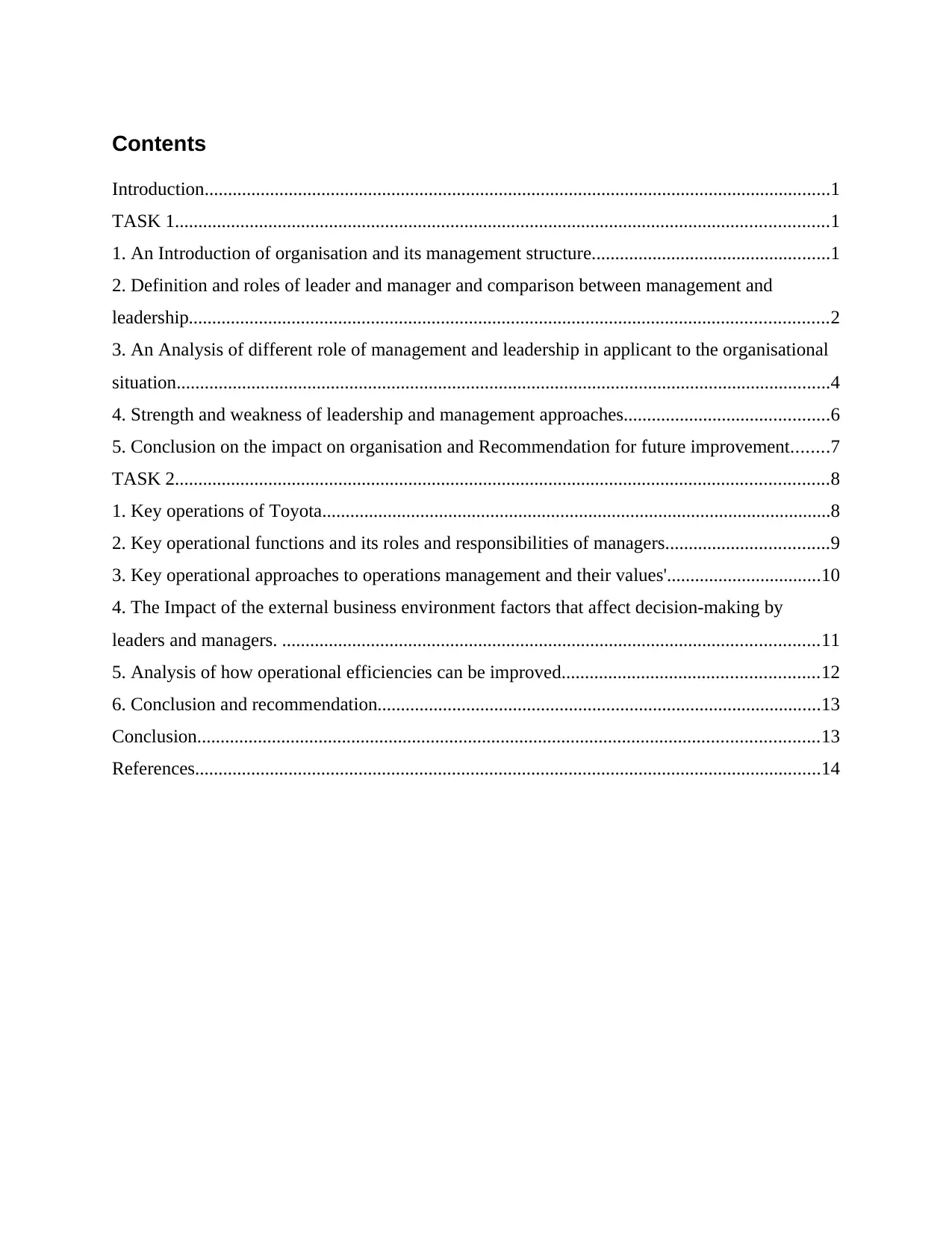
Contents
Introduction......................................................................................................................................1
TASK 1............................................................................................................................................1
1. An Introduction of organisation and its management structure...................................................1
2. Definition and roles of leader and manager and comparison between management and
leadership.........................................................................................................................................2
3. An Analysis of different role of management and leadership in applicant to the organisational
situation............................................................................................................................................4
4. Strength and weakness of leadership and management approaches............................................6
5. Conclusion on the impact on organisation and Recommendation for future improvement........7
TASK 2............................................................................................................................................8
1. Key operations of Toyota.............................................................................................................8
2. Key operational functions and its roles and responsibilities of managers...................................9
3. Key operational approaches to operations management and their values'.................................10
4. The Impact of the external business environment factors that affect decision-making by
leaders and managers. ...................................................................................................................11
5. Analysis of how operational efficiencies can be improved.......................................................12
6. Conclusion and recommendation...............................................................................................13
Conclusion.....................................................................................................................................13
References......................................................................................................................................14
Introduction......................................................................................................................................1
TASK 1............................................................................................................................................1
1. An Introduction of organisation and its management structure...................................................1
2. Definition and roles of leader and manager and comparison between management and
leadership.........................................................................................................................................2
3. An Analysis of different role of management and leadership in applicant to the organisational
situation............................................................................................................................................4
4. Strength and weakness of leadership and management approaches............................................6
5. Conclusion on the impact on organisation and Recommendation for future improvement........7
TASK 2............................................................................................................................................8
1. Key operations of Toyota.............................................................................................................8
2. Key operational functions and its roles and responsibilities of managers...................................9
3. Key operational approaches to operations management and their values'.................................10
4. The Impact of the external business environment factors that affect decision-making by
leaders and managers. ...................................................................................................................11
5. Analysis of how operational efficiencies can be improved.......................................................12
6. Conclusion and recommendation...............................................................................................13
Conclusion.....................................................................................................................................13
References......................................................................................................................................14
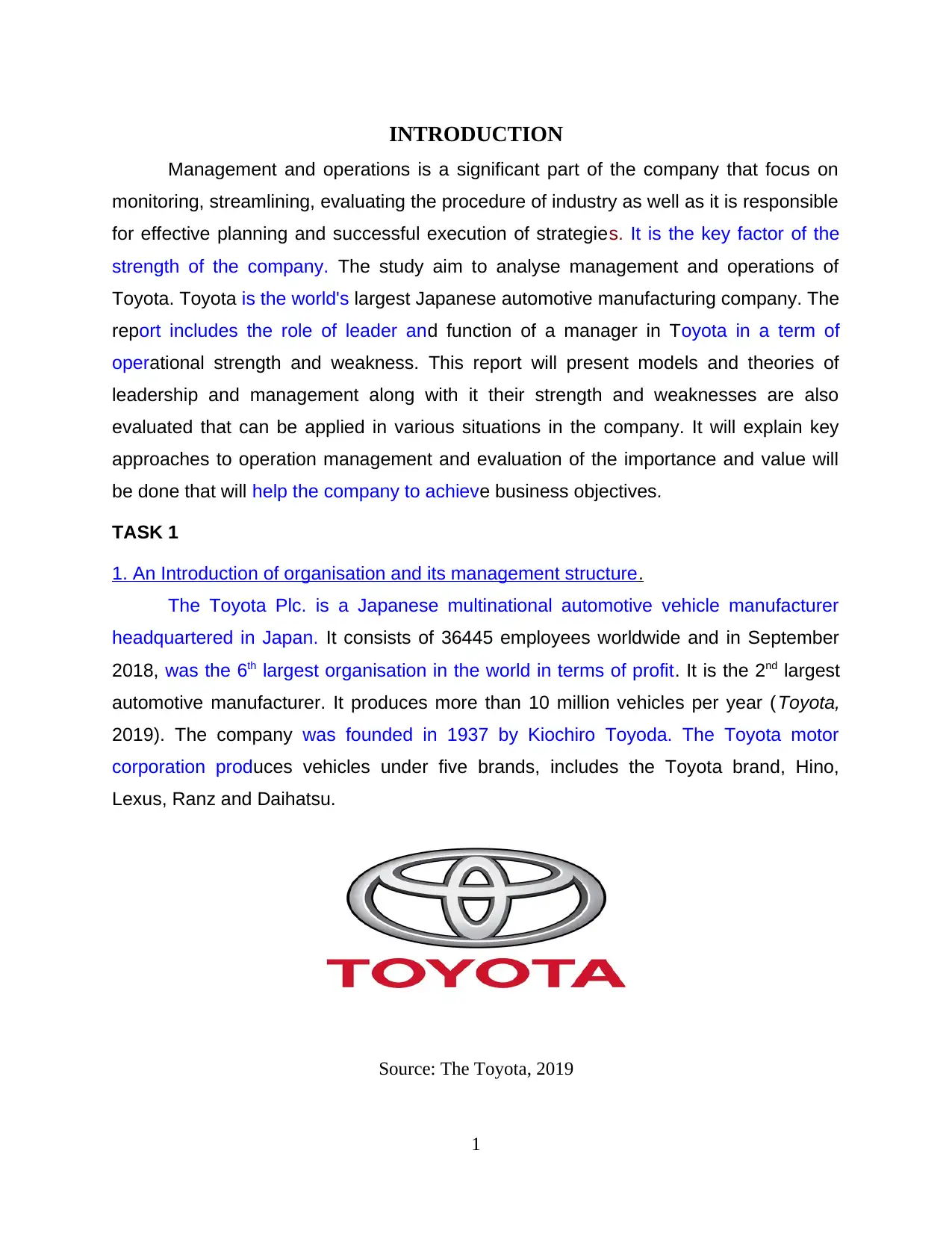
INTRODUCTION
Management and operations is a significant part of the company that focus on
monitoring, streamlining, evaluating the procedure of industry as well as it is responsible
for effective planning and successful execution of strategies. It is the key factor of the
strength of the company. The study aim to analyse management and operations of
Toyota. Toyota is the world's largest Japanese automotive manufacturing company. The
report includes the role of leader and function of a manager in Toyota in a term of
operational strength and weakness. This report will present models and theories of
leadership and management along with it their strength and weaknesses are also
evaluated that can be applied in various situations in the company. It will explain key
approaches to operation management and evaluation of the importance and value will
be done that will help the company to achieve business objectives.
TASK 1
1. An Introduction of organisation and its management structure.
The Toyota Plc. is a Japanese multinational automotive vehicle manufacturer
headquartered in Japan. It consists of 36445 employees worldwide and in September
2018, was the 6th largest organisation in the world in terms of profit. It is the 2nd largest
automotive manufacturer. It produces more than 10 million vehicles per year (Toyota,
2019). The company was founded in 1937 by Kiochiro Toyoda. The Toyota motor
corporation produces vehicles under five brands, includes the Toyota brand, Hino,
Lexus, Ranz and Daihatsu.
Source: The Toyota, 2019
1
Management and operations is a significant part of the company that focus on
monitoring, streamlining, evaluating the procedure of industry as well as it is responsible
for effective planning and successful execution of strategies. It is the key factor of the
strength of the company. The study aim to analyse management and operations of
Toyota. Toyota is the world's largest Japanese automotive manufacturing company. The
report includes the role of leader and function of a manager in Toyota in a term of
operational strength and weakness. This report will present models and theories of
leadership and management along with it their strength and weaknesses are also
evaluated that can be applied in various situations in the company. It will explain key
approaches to operation management and evaluation of the importance and value will
be done that will help the company to achieve business objectives.
TASK 1
1. An Introduction of organisation and its management structure.
The Toyota Plc. is a Japanese multinational automotive vehicle manufacturer
headquartered in Japan. It consists of 36445 employees worldwide and in September
2018, was the 6th largest organisation in the world in terms of profit. It is the 2nd largest
automotive manufacturer. It produces more than 10 million vehicles per year (Toyota,
2019). The company was founded in 1937 by Kiochiro Toyoda. The Toyota motor
corporation produces vehicles under five brands, includes the Toyota brand, Hino,
Lexus, Ranz and Daihatsu.
Source: The Toyota, 2019
1
⊘ This is a preview!⊘
Do you want full access?
Subscribe today to unlock all pages.

Trusted by 1+ million students worldwide
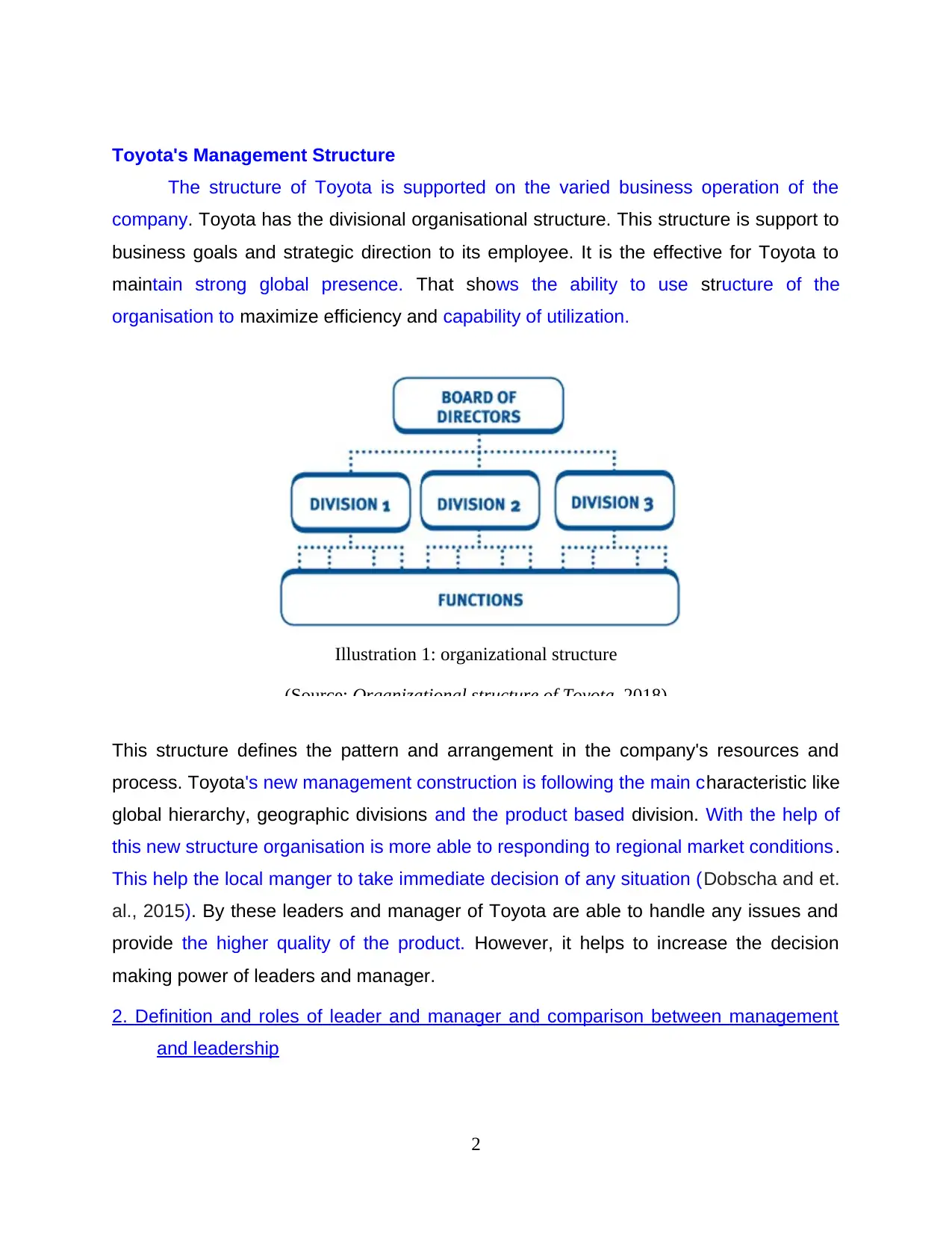
Toyota's Management Structure
The structure of Toyota is supported on the varied business operation of the
company. Toyota has the divisional organisational structure. This structure is support to
business goals and strategic direction to its employee. It is the effective for Toyota to
maintain strong global presence. That shows the ability to use structure of the
organisation to maximize efficiency and capability of utilization.
This structure defines the pattern and arrangement in the company's resources and
process. Toyota's new management construction is following the main characteristic like
global hierarchy, geographic divisions and the product based division. With the help of
this new structure organisation is more able to responding to regional market conditions.
This help the local manger to take immediate decision of any situation (Dobscha and et.
al., 2015). By these leaders and manager of Toyota are able to handle any issues and
provide the higher quality of the product. However, it helps to increase the decision
making power of leaders and manager.
2. Definition and roles of leader and manager and comparison between management
and leadership
2
Illustration 1: organizational structure
(Source: Organizational structure of Toyota, 2018)
The structure of Toyota is supported on the varied business operation of the
company. Toyota has the divisional organisational structure. This structure is support to
business goals and strategic direction to its employee. It is the effective for Toyota to
maintain strong global presence. That shows the ability to use structure of the
organisation to maximize efficiency and capability of utilization.
This structure defines the pattern and arrangement in the company's resources and
process. Toyota's new management construction is following the main characteristic like
global hierarchy, geographic divisions and the product based division. With the help of
this new structure organisation is more able to responding to regional market conditions.
This help the local manger to take immediate decision of any situation (Dobscha and et.
al., 2015). By these leaders and manager of Toyota are able to handle any issues and
provide the higher quality of the product. However, it helps to increase the decision
making power of leaders and manager.
2. Definition and roles of leader and manager and comparison between management
and leadership
2
Illustration 1: organizational structure
(Source: Organizational structure of Toyota, 2018)
Paraphrase This Document
Need a fresh take? Get an instant paraphrase of this document with our AI Paraphraser
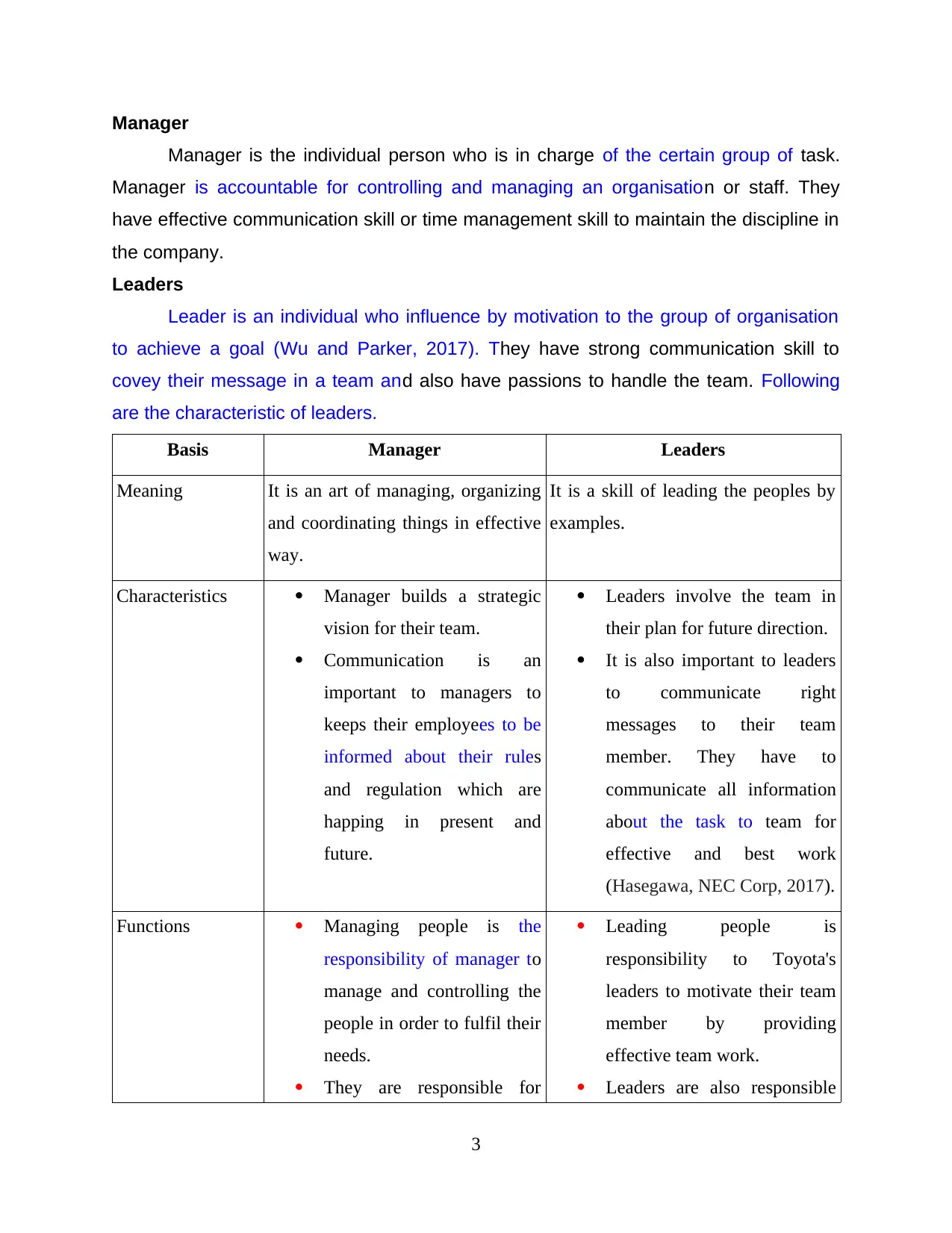
Manager
Manager is the individual person who is in charge of the certain group of task.
Manager is accountable for controlling and managing an organisation or staff. They
have effective communication skill or time management skill to maintain the discipline in
the company.
Leaders
Leader is an individual who influence by motivation to the group of organisation
to achieve a goal (Wu and Parker, 2017). They have strong communication skill to
covey their message in a team and also have passions to handle the team. Following
are the characteristic of leaders.
Basis Manager Leaders
Meaning It is an art of managing, organizing
and coordinating things in effective
way.
It is a skill of leading the peoples by
examples.
Characteristics Manager builds a strategic
vision for their team.
Communication is an
important to managers to
keeps their employees to be
informed about their rules
and regulation which are
happing in present and
future.
Leaders involve the team in
their plan for future direction.
It is also important to leaders
to communicate right
messages to their team
member. They have to
communicate all information
about the task to team for
effective and best work
(Hasegawa, NEC Corp, 2017).
Functions Managing people is the
responsibility of manager to
manage and controlling the
people in order to fulfil their
needs.
They are responsible for
Leading people is
responsibility to Toyota's
leaders to motivate their team
member by providing
effective team work.
Leaders are also responsible
3
Manager is the individual person who is in charge of the certain group of task.
Manager is accountable for controlling and managing an organisation or staff. They
have effective communication skill or time management skill to maintain the discipline in
the company.
Leaders
Leader is an individual who influence by motivation to the group of organisation
to achieve a goal (Wu and Parker, 2017). They have strong communication skill to
covey their message in a team and also have passions to handle the team. Following
are the characteristic of leaders.
Basis Manager Leaders
Meaning It is an art of managing, organizing
and coordinating things in effective
way.
It is a skill of leading the peoples by
examples.
Characteristics Manager builds a strategic
vision for their team.
Communication is an
important to managers to
keeps their employees to be
informed about their rules
and regulation which are
happing in present and
future.
Leaders involve the team in
their plan for future direction.
It is also important to leaders
to communicate right
messages to their team
member. They have to
communicate all information
about the task to team for
effective and best work
(Hasegawa, NEC Corp, 2017).
Functions Managing people is the
responsibility of manager to
manage and controlling the
people in order to fulfil their
needs.
They are responsible for
Leading people is
responsibility to Toyota's
leaders to motivate their team
member by providing
effective team work.
Leaders are also responsible
3
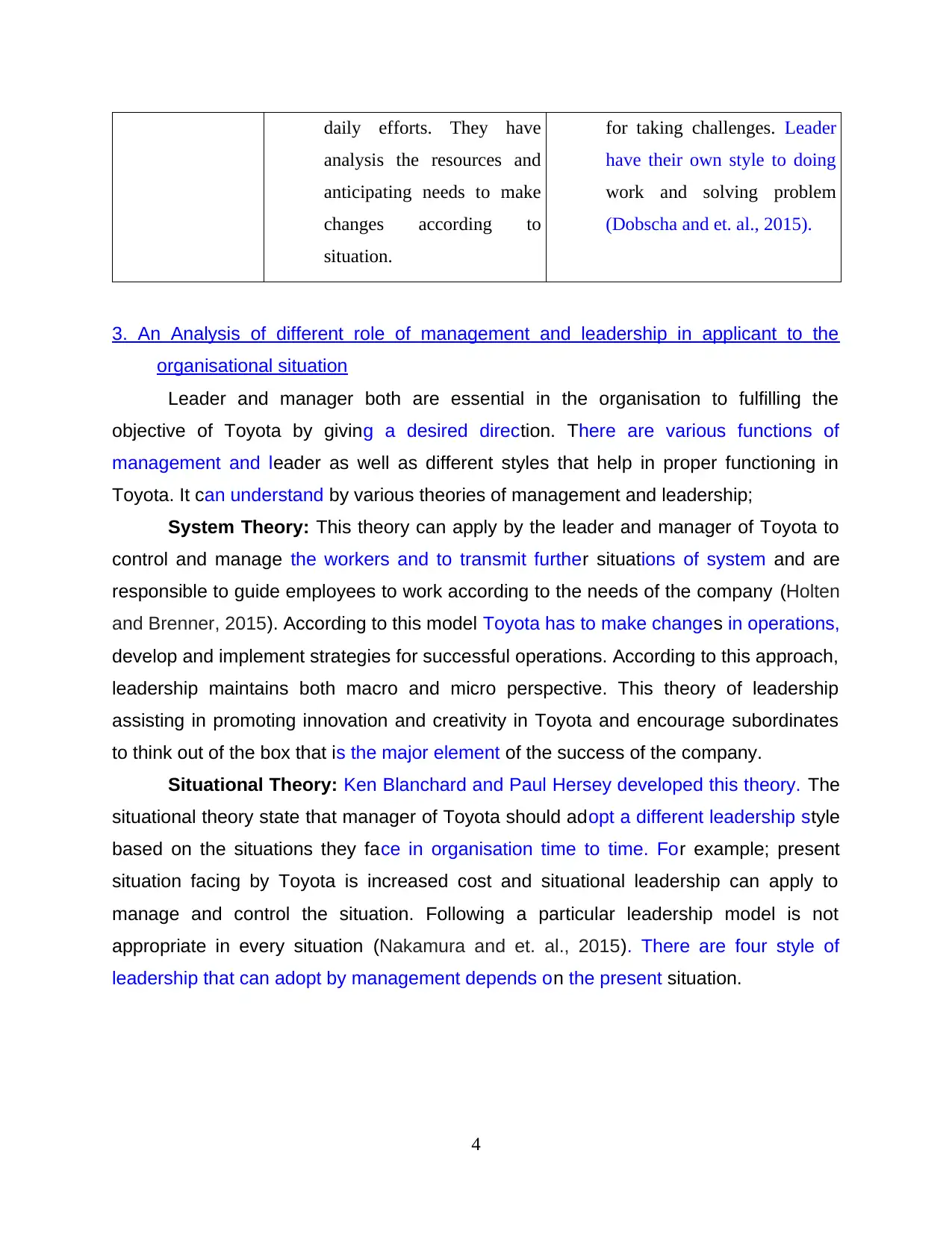
daily efforts. They have
analysis the resources and
anticipating needs to make
changes according to
situation.
for taking challenges. Leader
have their own style to doing
work and solving problem
(Dobscha and et. al., 2015).
3. An Analysis of different role of management and leadership in applicant to the
organisational situation
Leader and manager both are essential in the organisation to fulfilling the
objective of Toyota by giving a desired direction. There are various functions of
management and leader as well as different styles that help in proper functioning in
Toyota. It can understand by various theories of management and leadership;
System Theory: This theory can apply by the leader and manager of Toyota to
control and manage the workers and to transmit further situations of system and are
responsible to guide employees to work according to the needs of the company (Holten
and Brenner, 2015). According to this model Toyota has to make changes in operations,
develop and implement strategies for successful operations. According to this approach,
leadership maintains both macro and micro perspective. This theory of leadership
assisting in promoting innovation and creativity in Toyota and encourage subordinates
to think out of the box that is the major element of the success of the company.
Situational Theory: Ken Blanchard and Paul Hersey developed this theory. The
situational theory state that manager of Toyota should adopt a different leadership style
based on the situations they face in organisation time to time. For example; present
situation facing by Toyota is increased cost and situational leadership can apply to
manage and control the situation. Following a particular leadership model is not
appropriate in every situation (Nakamura and et. al., 2015). There are four style of
leadership that can adopt by management depends on the present situation.
4
analysis the resources and
anticipating needs to make
changes according to
situation.
for taking challenges. Leader
have their own style to doing
work and solving problem
(Dobscha and et. al., 2015).
3. An Analysis of different role of management and leadership in applicant to the
organisational situation
Leader and manager both are essential in the organisation to fulfilling the
objective of Toyota by giving a desired direction. There are various functions of
management and leader as well as different styles that help in proper functioning in
Toyota. It can understand by various theories of management and leadership;
System Theory: This theory can apply by the leader and manager of Toyota to
control and manage the workers and to transmit further situations of system and are
responsible to guide employees to work according to the needs of the company (Holten
and Brenner, 2015). According to this model Toyota has to make changes in operations,
develop and implement strategies for successful operations. According to this approach,
leadership maintains both macro and micro perspective. This theory of leadership
assisting in promoting innovation and creativity in Toyota and encourage subordinates
to think out of the box that is the major element of the success of the company.
Situational Theory: Ken Blanchard and Paul Hersey developed this theory. The
situational theory state that manager of Toyota should adopt a different leadership style
based on the situations they face in organisation time to time. For example; present
situation facing by Toyota is increased cost and situational leadership can apply to
manage and control the situation. Following a particular leadership model is not
appropriate in every situation (Nakamura and et. al., 2015). There are four style of
leadership that can adopt by management depends on the present situation.
4
⊘ This is a preview!⊘
Do you want full access?
Subscribe today to unlock all pages.

Trusted by 1+ million students worldwide
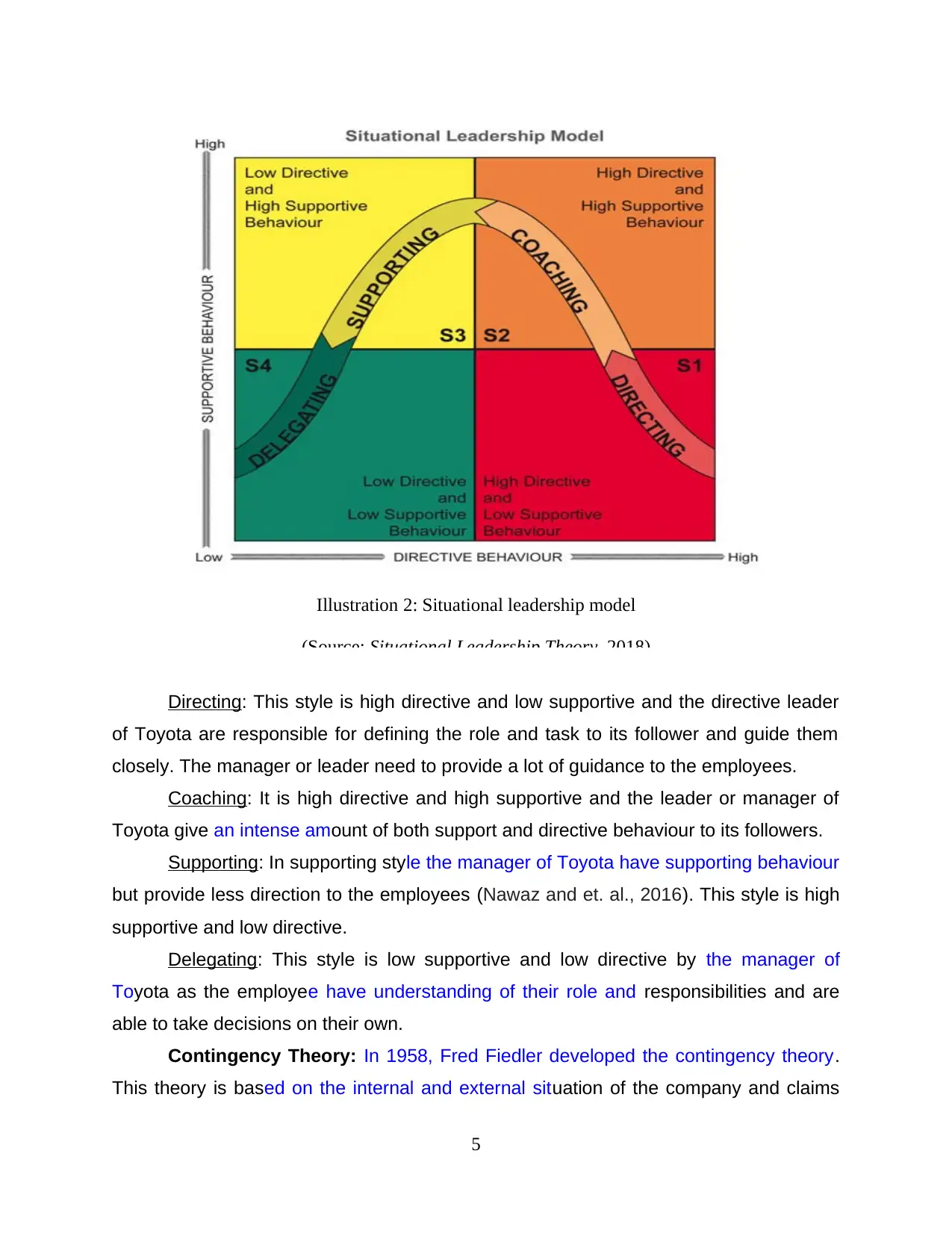
Directing: This style is high directive and low supportive and the directive leader
of Toyota are responsible for defining the role and task to its follower and guide them
closely. The manager or leader need to provide a lot of guidance to the employees.
Coaching: It is high directive and high supportive and the leader or manager of
Toyota give an intense amount of both support and directive behaviour to its followers.
Supporting: In supporting style the manager of Toyota have supporting behaviour
but provide less direction to the employees (Nawaz and et. al., 2016). This style is high
supportive and low directive.
Delegating: This style is low supportive and low directive by the manager of
Toyota as the employee have understanding of their role and responsibilities and are
able to take decisions on their own.
Contingency Theory: In 1958, Fred Fiedler developed the contingency theory.
This theory is based on the internal and external situation of the company and claims
5
Illustration 2: Situational leadership model
(Source: Situational Leadership Theory, 2018)
of Toyota are responsible for defining the role and task to its follower and guide them
closely. The manager or leader need to provide a lot of guidance to the employees.
Coaching: It is high directive and high supportive and the leader or manager of
Toyota give an intense amount of both support and directive behaviour to its followers.
Supporting: In supporting style the manager of Toyota have supporting behaviour
but provide less direction to the employees (Nawaz and et. al., 2016). This style is high
supportive and low directive.
Delegating: This style is low supportive and low directive by the manager of
Toyota as the employee have understanding of their role and responsibilities and are
able to take decisions on their own.
Contingency Theory: In 1958, Fred Fiedler developed the contingency theory.
This theory is based on the internal and external situation of the company and claims
5
Illustration 2: Situational leadership model
(Source: Situational Leadership Theory, 2018)
Paraphrase This Document
Need a fresh take? Get an instant paraphrase of this document with our AI Paraphraser
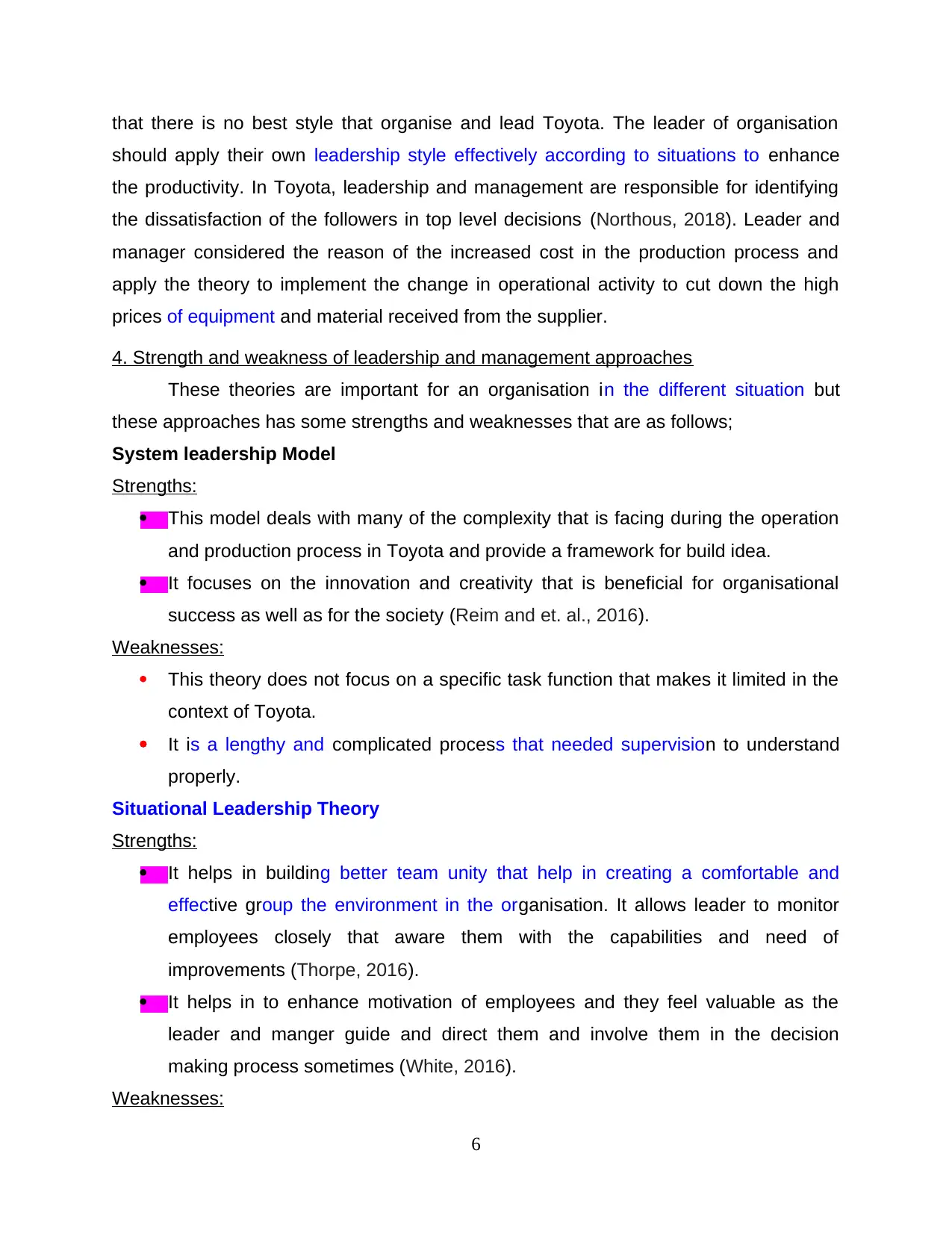
that there is no best style that organise and lead Toyota. The leader of organisation
should apply their own leadership style effectively according to situations to enhance
the productivity. In Toyota, leadership and management are responsible for identifying
the dissatisfaction of the followers in top level decisions (Northous, 2018). Leader and
manager considered the reason of the increased cost in the production process and
apply the theory to implement the change in operational activity to cut down the high
prices of equipment and material received from the supplier.
4. Strength and weakness of leadership and management approaches
These theories are important for an organisation in the different situation but
these approaches has some strengths and weaknesses that are as follows;
System leadership Model
Strengths:
This model deals with many of the complexity that is facing during the operation
and production process in Toyota and provide a framework for build idea.
It focuses on the innovation and creativity that is beneficial for organisational
success as well as for the society (Reim and et. al., 2016).
Weaknesses:
This theory does not focus on a specific task function that makes it limited in the
context of Toyota.
It is a lengthy and complicated process that needed supervision to understand
properly.
Situational Leadership Theory
Strengths:
It helps in building better team unity that help in creating a comfortable and
effective group the environment in the organisation. It allows leader to monitor
employees closely that aware them with the capabilities and need of
improvements (Thorpe, 2016).
It helps in to enhance motivation of employees and they feel valuable as the
leader and manger guide and direct them and involve them in the decision
making process sometimes (White, 2016).
Weaknesses:
6
should apply their own leadership style effectively according to situations to enhance
the productivity. In Toyota, leadership and management are responsible for identifying
the dissatisfaction of the followers in top level decisions (Northous, 2018). Leader and
manager considered the reason of the increased cost in the production process and
apply the theory to implement the change in operational activity to cut down the high
prices of equipment and material received from the supplier.
4. Strength and weakness of leadership and management approaches
These theories are important for an organisation in the different situation but
these approaches has some strengths and weaknesses that are as follows;
System leadership Model
Strengths:
This model deals with many of the complexity that is facing during the operation
and production process in Toyota and provide a framework for build idea.
It focuses on the innovation and creativity that is beneficial for organisational
success as well as for the society (Reim and et. al., 2016).
Weaknesses:
This theory does not focus on a specific task function that makes it limited in the
context of Toyota.
It is a lengthy and complicated process that needed supervision to understand
properly.
Situational Leadership Theory
Strengths:
It helps in building better team unity that help in creating a comfortable and
effective group the environment in the organisation. It allows leader to monitor
employees closely that aware them with the capabilities and need of
improvements (Thorpe, 2016).
It helps in to enhance motivation of employees and they feel valuable as the
leader and manger guide and direct them and involve them in the decision
making process sometimes (White, 2016).
Weaknesses:
6
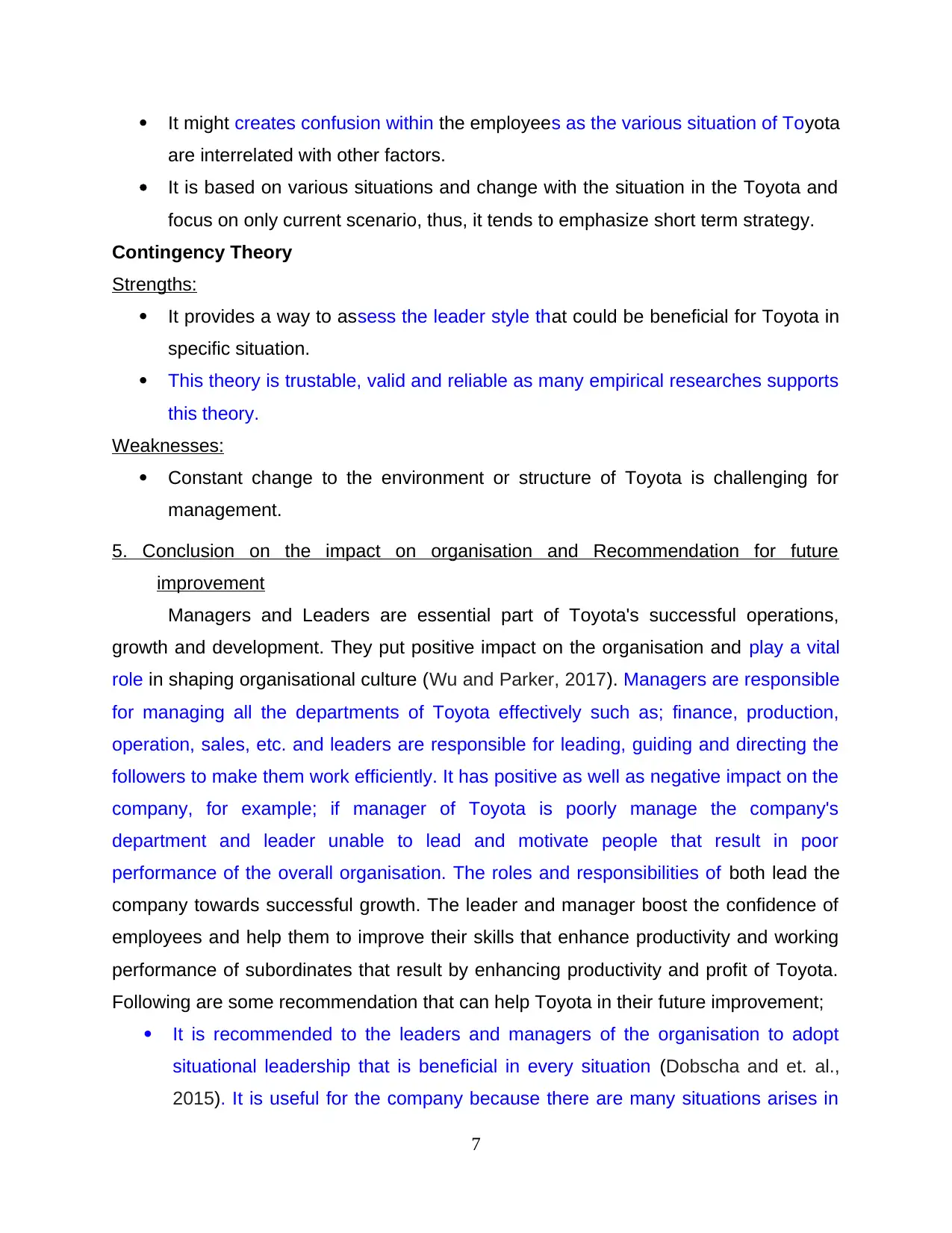
It might creates confusion within the employees as the various situation of Toyota
are interrelated with other factors.
It is based on various situations and change with the situation in the Toyota and
focus on only current scenario, thus, it tends to emphasize short term strategy.
Contingency Theory
Strengths:
It provides a way to assess the leader style that could be beneficial for Toyota in
specific situation.
This theory is trustable, valid and reliable as many empirical researches supports
this theory.
Weaknesses:
Constant change to the environment or structure of Toyota is challenging for
management.
5. Conclusion on the impact on organisation and Recommendation for future
improvement
Managers and Leaders are essential part of Toyota's successful operations,
growth and development. They put positive impact on the organisation and play a vital
role in shaping organisational culture (Wu and Parker, 2017). Managers are responsible
for managing all the departments of Toyota effectively such as; finance, production,
operation, sales, etc. and leaders are responsible for leading, guiding and directing the
followers to make them work efficiently. It has positive as well as negative impact on the
company, for example; if manager of Toyota is poorly manage the company's
department and leader unable to lead and motivate people that result in poor
performance of the overall organisation. The roles and responsibilities of both lead the
company towards successful growth. The leader and manager boost the confidence of
employees and help them to improve their skills that enhance productivity and working
performance of subordinates that result by enhancing productivity and profit of Toyota.
Following are some recommendation that can help Toyota in their future improvement;
It is recommended to the leaders and managers of the organisation to adopt
situational leadership that is beneficial in every situation (Dobscha and et. al.,
2015). It is useful for the company because there are many situations arises in
7
are interrelated with other factors.
It is based on various situations and change with the situation in the Toyota and
focus on only current scenario, thus, it tends to emphasize short term strategy.
Contingency Theory
Strengths:
It provides a way to assess the leader style that could be beneficial for Toyota in
specific situation.
This theory is trustable, valid and reliable as many empirical researches supports
this theory.
Weaknesses:
Constant change to the environment or structure of Toyota is challenging for
management.
5. Conclusion on the impact on organisation and Recommendation for future
improvement
Managers and Leaders are essential part of Toyota's successful operations,
growth and development. They put positive impact on the organisation and play a vital
role in shaping organisational culture (Wu and Parker, 2017). Managers are responsible
for managing all the departments of Toyota effectively such as; finance, production,
operation, sales, etc. and leaders are responsible for leading, guiding and directing the
followers to make them work efficiently. It has positive as well as negative impact on the
company, for example; if manager of Toyota is poorly manage the company's
department and leader unable to lead and motivate people that result in poor
performance of the overall organisation. The roles and responsibilities of both lead the
company towards successful growth. The leader and manager boost the confidence of
employees and help them to improve their skills that enhance productivity and working
performance of subordinates that result by enhancing productivity and profit of Toyota.
Following are some recommendation that can help Toyota in their future improvement;
It is recommended to the leaders and managers of the organisation to adopt
situational leadership that is beneficial in every situation (Dobscha and et. al.,
2015). It is useful for the company because there are many situations arises in
7
⊘ This is a preview!⊘
Do you want full access?
Subscribe today to unlock all pages.

Trusted by 1+ million students worldwide
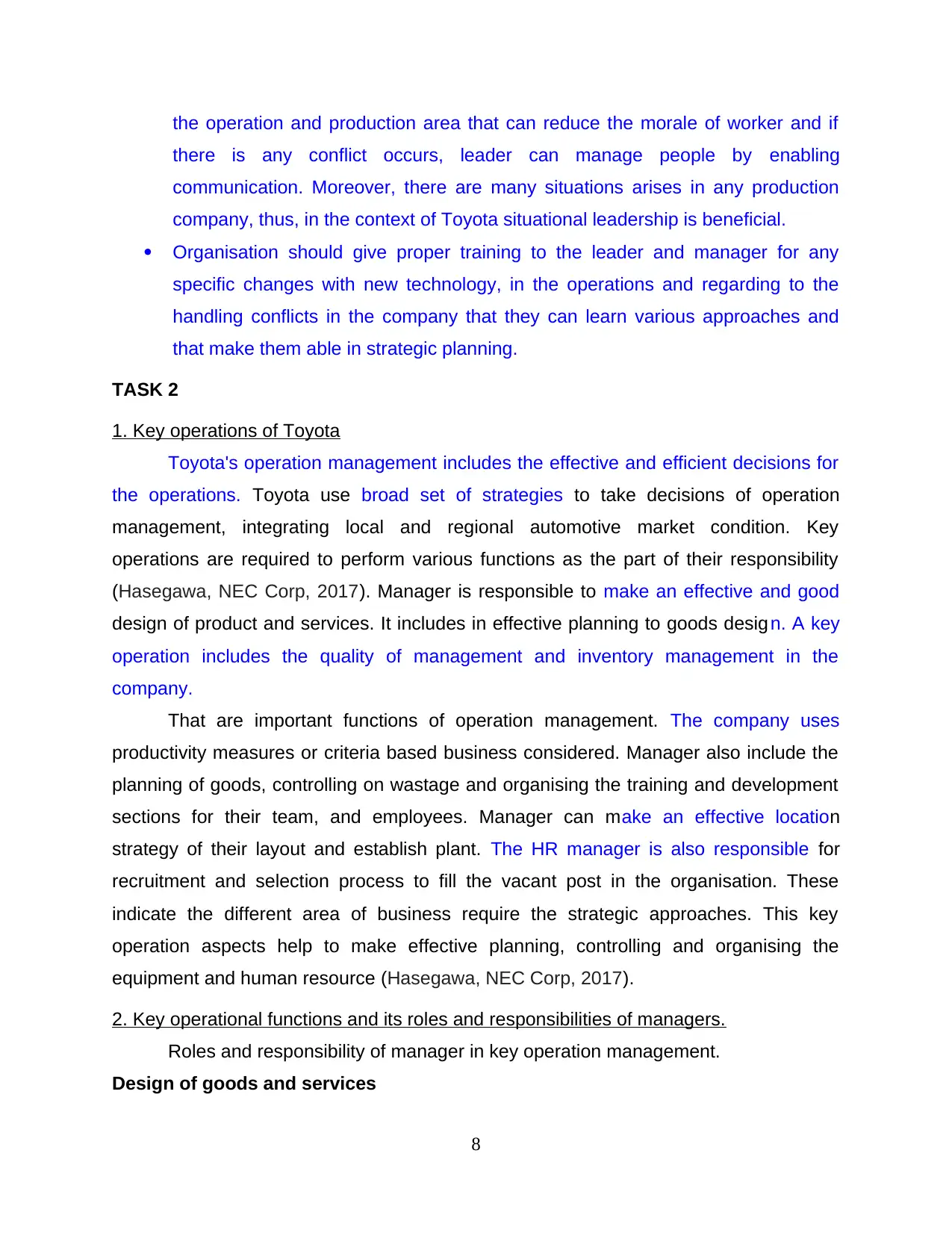
the operation and production area that can reduce the morale of worker and if
there is any conflict occurs, leader can manage people by enabling
communication. Moreover, there are many situations arises in any production
company, thus, in the context of Toyota situational leadership is beneficial.
Organisation should give proper training to the leader and manager for any
specific changes with new technology, in the operations and regarding to the
handling conflicts in the company that they can learn various approaches and
that make them able in strategic planning.
TASK 2
1. Key operations of Toyota
Toyota's operation management includes the effective and efficient decisions for
the operations. Toyota use broad set of strategies to take decisions of operation
management, integrating local and regional automotive market condition. Key
operations are required to perform various functions as the part of their responsibility
(Hasegawa, NEC Corp, 2017). Manager is responsible to make an effective and good
design of product and services. It includes in effective planning to goods desig n. A key
operation includes the quality of management and inventory management in the
company.
That are important functions of operation management. The company uses
productivity measures or criteria based business considered. Manager also include the
planning of goods, controlling on wastage and organising the training and development
sections for their team, and employees. Manager can make an effective location
strategy of their layout and establish plant. The HR manager is also responsible for
recruitment and selection process to fill the vacant post in the organisation. These
indicate the different area of business require the strategic approaches. This key
operation aspects help to make effective planning, controlling and organising the
equipment and human resource (Hasegawa, NEC Corp, 2017).
2. Key operational functions and its roles and responsibilities of managers.
Roles and responsibility of manager in key operation management.
Design of goods and services
8
there is any conflict occurs, leader can manage people by enabling
communication. Moreover, there are many situations arises in any production
company, thus, in the context of Toyota situational leadership is beneficial.
Organisation should give proper training to the leader and manager for any
specific changes with new technology, in the operations and regarding to the
handling conflicts in the company that they can learn various approaches and
that make them able in strategic planning.
TASK 2
1. Key operations of Toyota
Toyota's operation management includes the effective and efficient decisions for
the operations. Toyota use broad set of strategies to take decisions of operation
management, integrating local and regional automotive market condition. Key
operations are required to perform various functions as the part of their responsibility
(Hasegawa, NEC Corp, 2017). Manager is responsible to make an effective and good
design of product and services. It includes in effective planning to goods desig n. A key
operation includes the quality of management and inventory management in the
company.
That are important functions of operation management. The company uses
productivity measures or criteria based business considered. Manager also include the
planning of goods, controlling on wastage and organising the training and development
sections for their team, and employees. Manager can make an effective location
strategy of their layout and establish plant. The HR manager is also responsible for
recruitment and selection process to fill the vacant post in the organisation. These
indicate the different area of business require the strategic approaches. This key
operation aspects help to make effective planning, controlling and organising the
equipment and human resource (Hasegawa, NEC Corp, 2017).
2. Key operational functions and its roles and responsibilities of managers.
Roles and responsibility of manager in key operation management.
Design of goods and services
8
Paraphrase This Document
Need a fresh take? Get an instant paraphrase of this document with our AI Paraphraser
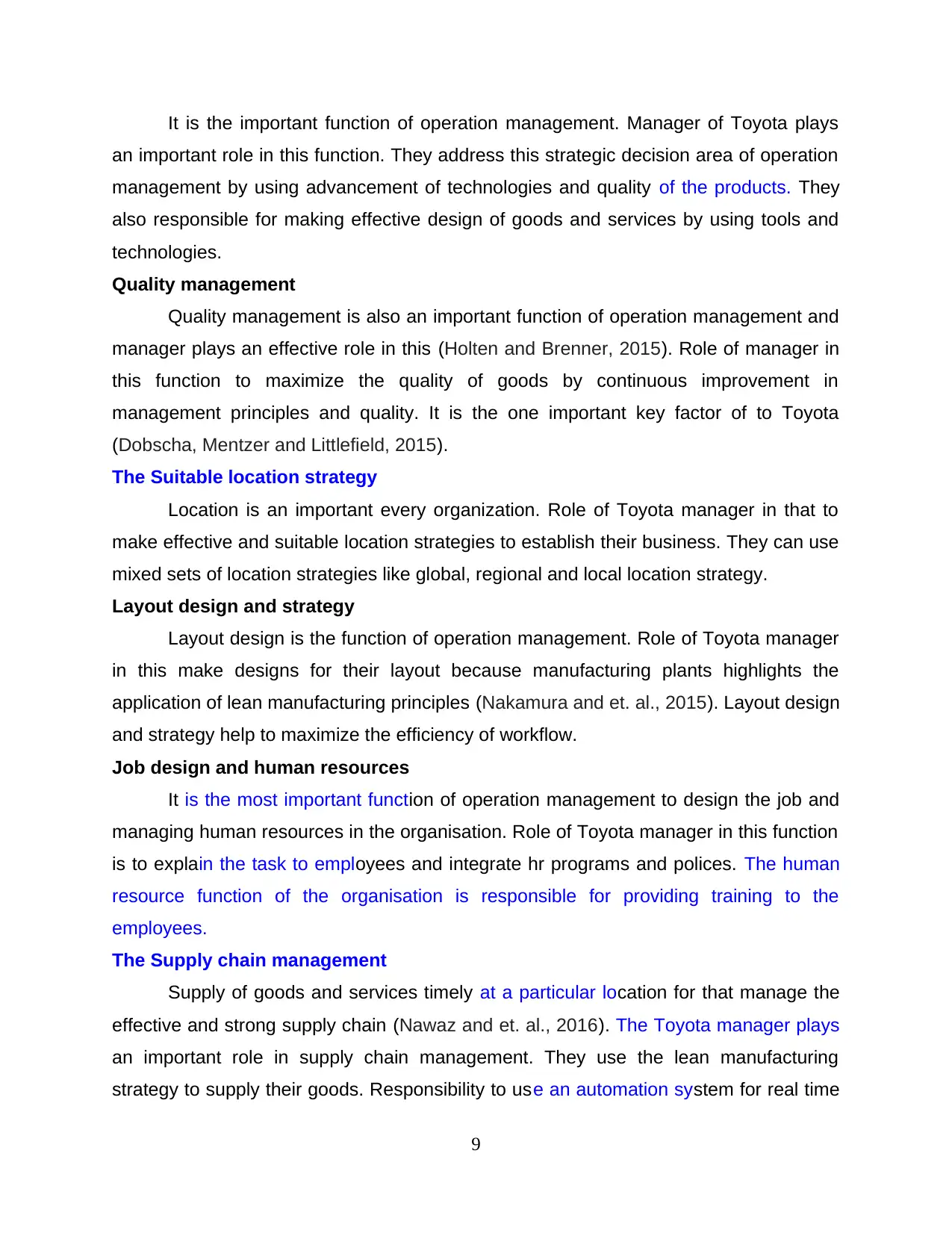
It is the important function of operation management. Manager of Toyota plays
an important role in this function. They address this strategic decision area of operation
management by using advancement of technologies and quality of the products. They
also responsible for making effective design of goods and services by using tools and
technologies.
Quality management
Quality management is also an important function of operation management and
manager plays an effective role in this (Holten and Brenner, 2015). Role of manager in
this function to maximize the quality of goods by continuous improvement in
management principles and quality. It is the one important key factor of to Toyota
(Dobscha, Mentzer and Littlefield, 2015).
The Suitable location strategy
Location is an important every organization. Role of Toyota manager in that to
make effective and suitable location strategies to establish their business. They can use
mixed sets of location strategies like global, regional and local location strategy.
Layout design and strategy
Layout design is the function of operation management. Role of Toyota manager
in this make designs for their layout because manufacturing plants highlights the
application of lean manufacturing principles (Nakamura and et. al., 2015). Layout design
and strategy help to maximize the efficiency of workflow.
Job design and human resources
It is the most important function of operation management to design the job and
managing human resources in the organisation. Role of Toyota manager in this function
is to explain the task to employees and integrate hr programs and polices. The human
resource function of the organisation is responsible for providing training to the
employees.
The Supply chain management
Supply of goods and services timely at a particular location for that manage the
effective and strong supply chain (Nawaz and et. al., 2016). The Toyota manager plays
an important role in supply chain management. They use the lean manufacturing
strategy to supply their goods. Responsibility to use an automation system for real time
9
an important role in this function. They address this strategic decision area of operation
management by using advancement of technologies and quality of the products. They
also responsible for making effective design of goods and services by using tools and
technologies.
Quality management
Quality management is also an important function of operation management and
manager plays an effective role in this (Holten and Brenner, 2015). Role of manager in
this function to maximize the quality of goods by continuous improvement in
management principles and quality. It is the one important key factor of to Toyota
(Dobscha, Mentzer and Littlefield, 2015).
The Suitable location strategy
Location is an important every organization. Role of Toyota manager in that to
make effective and suitable location strategies to establish their business. They can use
mixed sets of location strategies like global, regional and local location strategy.
Layout design and strategy
Layout design is the function of operation management. Role of Toyota manager
in this make designs for their layout because manufacturing plants highlights the
application of lean manufacturing principles (Nakamura and et. al., 2015). Layout design
and strategy help to maximize the efficiency of workflow.
Job design and human resources
It is the most important function of operation management to design the job and
managing human resources in the organisation. Role of Toyota manager in this function
is to explain the task to employees and integrate hr programs and polices. The human
resource function of the organisation is responsible for providing training to the
employees.
The Supply chain management
Supply of goods and services timely at a particular location for that manage the
effective and strong supply chain (Nawaz and et. al., 2016). The Toyota manager plays
an important role in supply chain management. They use the lean manufacturing
strategy to supply their goods. Responsibility to use an automation system for real time
9
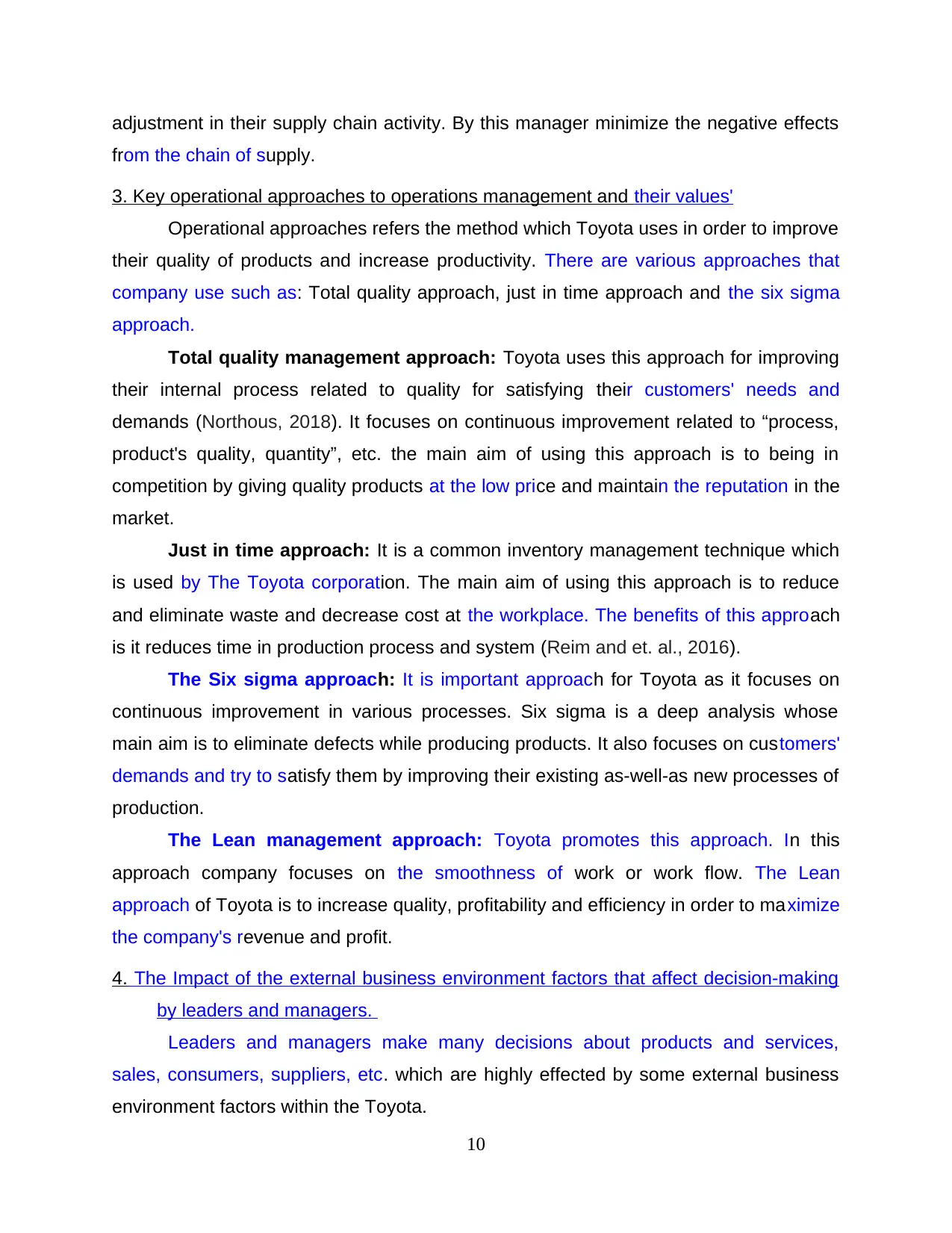
adjustment in their supply chain activity. By this manager minimize the negative effects
from the chain of supply.
3. Key operational approaches to operations management and their values'
Operational approaches refers the method which Toyota uses in order to improve
their quality of products and increase productivity. There are various approaches that
company use such as: Total quality approach, just in time approach and the six sigma
approach.
Total quality management approach: Toyota uses this approach for improving
their internal process related to quality for satisfying their customers' needs and
demands (Northous, 2018). It focuses on continuous improvement related to “process,
product's quality, quantity”, etc. the main aim of using this approach is to being in
competition by giving quality products at the low price and maintain the reputation in the
market.
Just in time approach: It is a common inventory management technique which
is used by The Toyota corporation. The main aim of using this approach is to reduce
and eliminate waste and decrease cost at the workplace. The benefits of this approach
is it reduces time in production process and system (Reim and et. al., 2016).
The Six sigma approach: It is important approach for Toyota as it focuses on
continuous improvement in various processes. Six sigma is a deep analysis whose
main aim is to eliminate defects while producing products. It also focuses on customers'
demands and try to satisfy them by improving their existing as-well-as new processes of
production.
The Lean management approach: Toyota promotes this approach. In this
approach company focuses on the smoothness of work or work flow. The Lean
approach of Toyota is to increase quality, profitability and efficiency in order to maximize
the company's revenue and profit.
4. The Impact of the external business environment factors that affect decision-making
by leaders and managers.
Leaders and managers make many decisions about products and services,
sales, consumers, suppliers, etc. which are highly effected by some external business
environment factors within the Toyota.
10
from the chain of supply.
3. Key operational approaches to operations management and their values'
Operational approaches refers the method which Toyota uses in order to improve
their quality of products and increase productivity. There are various approaches that
company use such as: Total quality approach, just in time approach and the six sigma
approach.
Total quality management approach: Toyota uses this approach for improving
their internal process related to quality for satisfying their customers' needs and
demands (Northous, 2018). It focuses on continuous improvement related to “process,
product's quality, quantity”, etc. the main aim of using this approach is to being in
competition by giving quality products at the low price and maintain the reputation in the
market.
Just in time approach: It is a common inventory management technique which
is used by The Toyota corporation. The main aim of using this approach is to reduce
and eliminate waste and decrease cost at the workplace. The benefits of this approach
is it reduces time in production process and system (Reim and et. al., 2016).
The Six sigma approach: It is important approach for Toyota as it focuses on
continuous improvement in various processes. Six sigma is a deep analysis whose
main aim is to eliminate defects while producing products. It also focuses on customers'
demands and try to satisfy them by improving their existing as-well-as new processes of
production.
The Lean management approach: Toyota promotes this approach. In this
approach company focuses on the smoothness of work or work flow. The Lean
approach of Toyota is to increase quality, profitability and efficiency in order to maximize
the company's revenue and profit.
4. The Impact of the external business environment factors that affect decision-making
by leaders and managers.
Leaders and managers make many decisions about products and services,
sales, consumers, suppliers, etc. which are highly effected by some external business
environment factors within the Toyota.
10
⊘ This is a preview!⊘
Do you want full access?
Subscribe today to unlock all pages.

Trusted by 1+ million students worldwide
1 out of 17
Related Documents
Your All-in-One AI-Powered Toolkit for Academic Success.
+13062052269
info@desklib.com
Available 24*7 on WhatsApp / Email
![[object Object]](/_next/static/media/star-bottom.7253800d.svg)
Unlock your academic potential
Copyright © 2020–2025 A2Z Services. All Rights Reserved. Developed and managed by ZUCOL.





